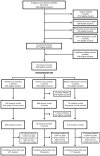Great Taste, Less Waste: a cluster-randomized trial using a communications campaign to improve the quality of foods brought from home to school by elementary school children
- PMID: 25735605
- PMCID: PMC4640453
- DOI: 10.1016/j.ypmed.2015.02.010
Great Taste, Less Waste: a cluster-randomized trial using a communications campaign to improve the quality of foods brought from home to school by elementary school children
Abstract
Objective: Great Taste, Less Waste (GTLW), a communications campaign, capitalized on the synergy between healthy eating and eco-friendly behaviors to motivate children to bring more fruits and vegetables and fewer sugar-sweetened beverages (SSBs) to school.
Methods: A cluster-randomized trial in Eastern Massachusetts elementary schools in 2011-2012 tested the hypothesis that GTLW would improve the quality of foods from home more than a nutrition-only campaign--Foods 2 Choose (F2C)--or control. Lunch and snack items from home were measured at baseline and 7 months later using digital photography. Mixed linear models compared change in mean servings of fruits, vegetables, and SSBs among groups, and change in mean prevalence of packaging type. Change in prevalence of food items of interest was compared among groups using generalized linear models.
Results: Five hundred and eighty-two third and fourth graders from 82 classrooms in 12 schools participated. At follow-up, no significant differences were observed between groups in change in mean servings or change in prevalence of items of interest. No packaging differences were observed.
Conclusion: GTLW was well received, but no significant changes were observed in the quality of food brought to school. Whether classrooms are an effective environment for change remains to be explored. ClinicalTrials.gov identifier: NCT0157384.
Trial registration: ClinicalTrials.gov NCT01573845.
Keywords: Behavioral intervention; Elementary school children; Fruits and vegetables; Innovative approaches; Nutrition communication.
Copyright © 2015 Elsevier Inc. All rights reserved.
Conflict of interest statement
All authors declare no conflict of interest.
Figures



References
-
- Ajzen I, Fishbein M. Understanding attitudes and predicting social behavior. Englewood Cliffs, NJ: Prentice-Hall; 1980.
-
- Arvola A, Vassallo M, Dean M, Lampila P, Saba A, Lahteenmaki L, Shepherd R. Predicting intentions to purchase organic food: The role of affective and moral attitudes in the Theory of Planned Behaviour. Appetite. 2008;50:443–54. - PubMed
-
- Bandura A. Social foundations of thought and action: A social cognitive theory. Prentice-Hall, Inc; Englewood Cliffs, NJ, US: 1986.
-
- Barr S. Strategies for sustainability: citizens and responsible environmental behaviour. Area. 2003;35:227–40.
-
- Bathgate K, Begley A. ‘It’s very hard to find what to put in the kid’s lunch’: What Perth parents think about food for school lunch boxes. Nutr Diet. 2011;68:21–26.
Publication types
MeSH terms
Associated data
Grants and funding
LinkOut - more resources
Full Text Sources
Other Literature Sources
Medical

